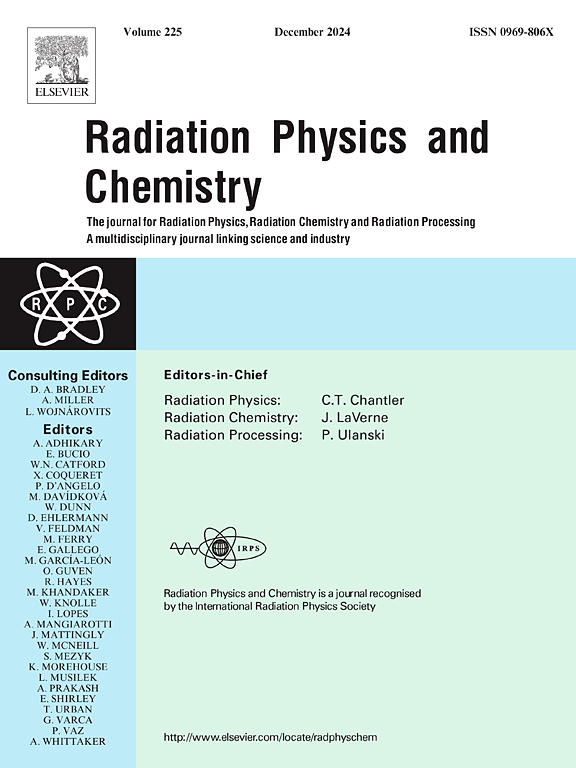An investigation of some ionizing radiation interaction parameters with selected composition alloys
IF 2.8
3区 物理与天体物理
Q3 CHEMISTRY, PHYSICAL
引用次数: 0
Abstract
The present work examined γ-ray and neutron shielding capabilities of substances, including CS(516), SS(403), SS(410), SS(316), SS(316L), SS(304L), Incoloy-(600), Monel-(400), and Cupero_Nickel. Via the calculation of Half Value Layer (HVL), Effective atomic number (Zeff), Mean free path (MFP), Effective conductivity (Ceff), transmission factor (TF) and the dose rate (Dr). Fast neutron removal cross-section ∑R and total macroscopic cross-section ∑t, the association involving mean excitation energies of electrons and sample density, some charged ions variety at different energies, stopping power (SP) and CSDA range (R) of electrons and Transmission coefficient for several materials at varying incoming gamma ray energy. The efficiency of the alloys as gamma shields was examined using software (Phy_X/PSD and Py_MLBUF), while SRIM Monte Carlo software was used to calculate the range of charged ions at chosen energies between 0.01 and 20 MeV. At 0.025 eV and 4 MeV, the thermal and fast neutron removal factors were calculated using the NGCal software. The alloys fast neutron removal cross section was computed using the partial density method. Gamma ray shielding was found to be optimal with cupro_nickel. In the energy range of 0.02–15 MeV for neutrons, SS–316 was discovered to be the best shielding material. The current research should be helpful for choosing appropriate materials for γ-ray and neutron shielding in various industries as well as for probable uses of these materials in nuclear reactor core design.
电离辐射与特定成分合金相互作用参数的研究
本研究考察了 CS(516)、SS(403)、SS(410)、SS(316)、SS(316L)、SS(304L)、Incoloy-(600)、Monel-(400) 和 Cupero_Nickel 等物质的γ 射线和中子屏蔽能力。通过计算半值层(HVL)、有效原子序数(Zeff)、平均自由路径(MFP)、有效电导率(Ceff)、透射系数(TF)和剂量率(Dr)。快中子去除截面∑R 和总宏观截面∑t、电子平均激发能量与样品密度的关系、不同能量下的带电离子种类、电子的阻挡功率(SP)和 CSDA 范围(R)以及几种材料在不同伽马射线射入能量下的透射系数。使用软件(Phy_X/PSD 和 Py_MLBUF)检验了合金作为伽马屏蔽的效率,同时使用 SRIM Monte Carlo 软件计算了在 0.01 至 20 MeV 的选定能量下带电离子的范围。在 0.025 eV 和 4 MeV 时,使用 NGCal 软件计算热中子和快中子去除因子。合金的快中子去除截面是用部分密度法计算得出的。发现铜镍合金的伽马射线屏蔽效果最佳。在 0.02-15 MeV 的中子能量范围内,发现 SS-316 是最佳屏蔽材料。目前的研究应有助于为各行各业的γ射线和中子屏蔽选择合适的材料,以及这些材料在核反应堆堆芯设计中的可能用途。
本文章由计算机程序翻译,如有差异,请以英文原文为准。
求助全文
约1分钟内获得全文
求助全文
来源期刊

Radiation Physics and Chemistry
化学-核科学技术
CiteScore
5.60
自引率
17.20%
发文量
574
审稿时长
12 weeks
期刊介绍:
Radiation Physics and Chemistry is a multidisciplinary journal that provides a medium for publication of substantial and original papers, reviews, and short communications which focus on research and developments involving ionizing radiation in radiation physics, radiation chemistry and radiation processing.
The journal aims to publish papers with significance to an international audience, containing substantial novelty and scientific impact. The Editors reserve the rights to reject, with or without external review, papers that do not meet these criteria. This could include papers that are very similar to previous publications, only with changed target substrates, employed materials, analyzed sites and experimental methods, report results without presenting new insights and/or hypothesis testing, or do not focus on the radiation effects.
 求助内容:
求助内容: 应助结果提醒方式:
应助结果提醒方式:


